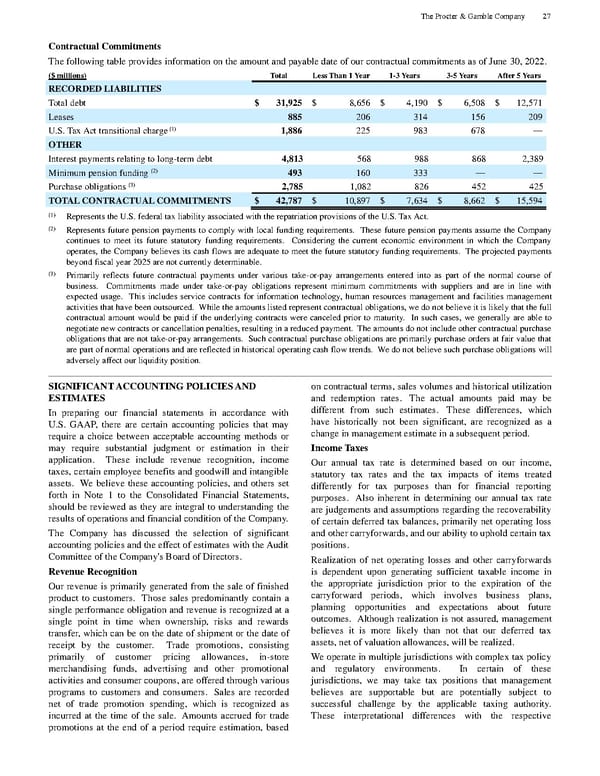Contractual Commitments The following table provides information on the amount and payable date of our contractual commitments as of June 30, 2022. ($ millions) Total Less Than 1 Year 1 - 3 Years 3 - 5 Years After 5 Years RECORDED LIABILITIES Total debt $ 31,925 $ 8,656 $ 4,190 $ 6,508 $ 12,571 Leases 885 206 314 156 209 U.S. Tax Act transitional charge (1) 1,886 225 983 678 — OTHER Interest payments relating to long - term debt 4,813 568 988 868 2,389 Minimum pension funding (2) 493 160 333 — — Purchase obligations (3) 2,785 1,082 826 452 425 TOTAL CONTRACTUAL COMMITMENTS $ 42,787 $ 10,897 $ 7,634 $ 8,662 $ 15,594 (1) Represents the U.S. federal tax liability associated with the repatriation provisions of the U.S. Tax Act. (2) Represents future pension payments to comply with local funding requirements. These future pension payments assume the Company continues to meet its future statutory funding requirements. Considering the current economic environment in which the Compa ny operates, the Company believes its cash flows are adequate to meet the future statutory funding requirements. The p rojected payments beyond fiscal year 2025 are not currently determinable. (3) Primarily reflects future contractual payments under various take - or - pay arrangements entered into as part of the normal course of business. Commitments made under take - or - pay o bligations represent minimum commitments with suppliers and are in line with expected usage. This includes service contracts for information technology, human resources management and facilities manage ment activities that have been outsourced. While the amounts listed represent contractual obligations, we do not believe it is likely that the full contractual amount would be paid if the underlying contracts were canceled prior to maturity. In such cases, we generally ar e able to negotiate new contracts or cancellation penalties, resulting in a reduced payment. The amounts do not include other contractual purchase obligations that are not take - or - pay arrangements. Such contractual purchase obligations are primarily purchase orders at fair value that are p art of normal operations and are reflected in historical operating cash flow trends. We do not believe such purchase obligat ions will adversely affect our liquidity position. SIGNIFICANT ACCOUNTING POLICIES AND ESTIMATES In preparin g our financial statements in accordance with U.S. GAAP, there are certain accounting policies that may require a choice between acceptable accounting methods or may require substantial judgment or estimation in their application. These include revenue re cognition, income taxes, certain employee benefits and goodwill and intangible assets. We believe these accounting policies, and others set forth in Note 1 to the Consolidated Financial Statements, should be reviewed as they are integral to understanding the results of operations and financial condition of the Company. The Company has discussed the selection of significant accounting policies and the effect of estimates with the Audit Committee of the Company's Board of Directors. Revenue Recognition Our r evenue is primarily generated from the sale of finished product to customers. Those sales predominantly contain a single performance obligation and revenue is recognized at a single point in time when ownership, risks and rewards transfer, which can be on the date of shipment or the date of receipt by the customer. Trade promotions, consisting primarily of customer pricing allowances, in - store merchandising funds, advertising and other promotional activities and consumer coupons, are offered through vario us programs to customers and consumers. Sales are recorded net of trade promotion spending, which is recognized as incurred at the time of the sale. Amounts accrued for trade promotions at the end of a period require estimation, based on contractual term s, sales volumes and historical utilization and redemption rates. The actual amounts paid may be different from such estimates. These differences, which have historically not been significant, are recognized as a change in management estimate in a subseq uent period. Income Taxes Our annual tax rate is determined based on our income, statutory tax rates and the tax impacts of items treated differently for tax purposes than for financial reporting purposes. Also inherent in determining our annual tax rat e are judgements and assumptions regarding the recoverability of certain deferred tax balances, primarily net operating loss and other carryforwards, and our ability to uphold certain tax positions. Realization of net operating losses and other carryforwar ds is dependent upon generating sufficient taxable income in the appropriate jurisdiction prior to the expiration of the carryforward periods, which involves business plans, planning opportunities and expectations about future outcomes. Although realizati on is not assured, management believes it is more likely than not that our deferred tax assets, net of valuation allowances, will be realized. We operate in multiple jurisdictions with complex tax policy and regulatory environments. In certain of these ju risdictions, we may take tax positions that management believes are supportable but are potentially subject to successful challenge by the applicable taxing authority. These interpretational differences with the respective The Procter & Gamble Company 27
 The Procter & Gamble Annual Report Page 38 Page 40
The Procter & Gamble Annual Report Page 38 Page 40